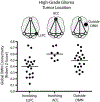Altered functional connectivity of the default mode network in diffuse gliomas measured with pseudo-resting state fMRI
- PMID: 24234804
- PMCID: PMC6763342
- DOI: 10.1007/s11060-013-1304-2
Altered functional connectivity of the default mode network in diffuse gliomas measured with pseudo-resting state fMRI
Abstract
The purpose of the current study was to explore whether brain tumors disrupt the integrity of the default mode network (DMN), a well-characterized resting-state fMRI network. We evaluated whether tumor grade, volume, post-surgical/clinical status, or location decreased the functional connectivity within the DMN in patients with gliomas. Task-based fMRI data was obtained from 68 diffuse glioma patients and 12 healthy volunteers. Pseudo-resting state fMRI data was calculated from task-based fMRI data using standard techniques. Data was preprocessed and DMN integrity was compared across WHO grade, tumor volume surgical status (new vs. recurrent tumors), age, and KPS using univariate and multivariate linear models. WHO grade was the most significant predictor of DMN integrity (P = 0.004), whereas T2 hyperintense lesion volume was not a predictor (P = 0.154). DMN integrity was lower in high-grade (WHO III–IV) compared with low-grade (WHO II) patients (P = 0.020). Tumors in the left parietal lobe showed a more impaired DMN compared with tumors in the frontal lobe, while tumors within and outside the network nodes did not differ significantly. Results suggest higher tumor grade along with prior surgery and/or treatment cause the largest reduction in DMN functional connectivity in patients with primary gliomas, and that tumor location has an impact on connectivity.
Figures




Similar articles
-
Role of the default mode resting-state network for cognitive functioning in malignant glioma patients following multimodal treatment.Neuroimage Clin. 2020;27:102287. doi: 10.1016/j.nicl.2020.102287. Epub 2020 May 26. Neuroimage Clin. 2020. PMID: 32540630 Free PMC article.
-
Exploratory study of the effect of brain tumors on the default mode network.J Neurooncol. 2016 Jul;128(3):437-44. doi: 10.1007/s11060-016-2129-6. Epub 2016 Apr 18. J Neurooncol. 2016. PMID: 27090892
-
Modifications of default-mode network connectivity in patients with cerebral glioma.PLoS One. 2012;7(7):e40231. doi: 10.1371/journal.pone.0040231. Epub 2012 Jul 9. PLoS One. 2012. PMID: 22808124 Free PMC article.
-
Dysregulation within the salience network and default mode network in hyperthyroid patients: a follow-up resting-state functional MRI study.Brain Imaging Behav. 2020 Feb;14(1):30-41. doi: 10.1007/s11682-018-9961-6. Brain Imaging Behav. 2020. PMID: 30259292 Review.
-
Functional connectomics from resting-state fMRI.Trends Cogn Sci. 2013 Dec;17(12):666-82. doi: 10.1016/j.tics.2013.09.016. Epub 2013 Nov 12. Trends Cogn Sci. 2013. PMID: 24238796 Free PMC article. Review.
Cited by
-
A method for safely resecting anterior butterfly gliomas: the surgical anatomy of the default mode network and the relevance of its preservation.J Neurosurg. 2017 Jun;126(6):1795-1811. doi: 10.3171/2016.5.JNS153006. Epub 2016 Sep 16. J Neurosurg. 2017. PMID: 27636183 Free PMC article.
-
Correlation between brain functional connectivity and neurocognitive function in patients with left frontal glioma.Sci Rep. 2022 Nov 8;12(1):18302. doi: 10.1038/s41598-022-22493-6. Sci Rep. 2022. PMID: 36347905 Free PMC article.
-
Cognitive functioning and functional brain networks in postoperative WHO grade I meningioma patients.J Neurooncol. 2018 Dec;140(3):605-613. doi: 10.1007/s11060-018-2987-1. Epub 2018 Sep 15. J Neurooncol. 2018. PMID: 30219943 Free PMC article.
-
Human Brain Functional Network Organization Is Disrupted After Whole-Brain Radiation Therapy.Brain Connect. 2020 Feb;10(1):29-38. doi: 10.1089/brain.2019.0713. Brain Connect. 2020. PMID: 31964163 Free PMC article.
-
Phase II study of tivozanib, an oral VEGFR inhibitor, in patients with recurrent glioblastoma.J Neurooncol. 2017 Feb;131(3):603-610. doi: 10.1007/s11060-016-2332-5. Epub 2016 Nov 16. J Neurooncol. 2017. PMID: 27853960 Free PMC article. Clinical Trial.
References
Publication types
MeSH terms
Substances
Grants and funding
LinkOut - more resources
Full Text Sources
Other Literature Sources
Medical

